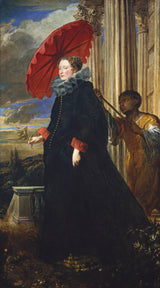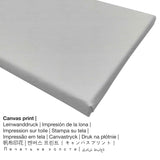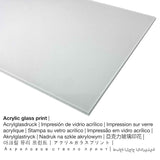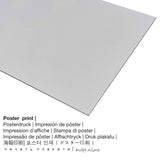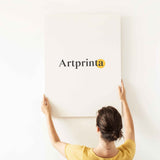Anthony van Dyck, 1623 - Marchesa Elena Grimaldi Cattaneo - ọmarịcha nka
Ụtụ gụnyere. Mbupu gbakọrọ na ndenye ọpụpụ.
Marchesa Elena Grimaldi Cattaneo is a piece of art created by the Dutch painter Anthony van Dyck. The 390 eserese dị afọ na-atụ nha - 242,9 x 138,5 cm (95 5/8 x 54 1/2 na). Mmanụ na kwaaji was applied by the painter as the technique for the artwork. The artpiece is included in the digital collection of National Gallery of Art, which is the museum of the US-American nation that preserves, collects, exhibits, and fosters an understanding of works of art. This masterpiece, which belongs to the ngalaba ọha a na-enye ya site n'ikike nke National Gallery of Art, Washington.Kridi n'obi nke artpiece bụ ndị a: . Ọzọkwa, itinye n'usoro mmepụta dijitalụ na-abanye Eserese format na a akụkụ ruru nke 9: 16, nke pụtara na ogologo bụ 45% mkpụmkpụ karịa obosara. The translator, author, dramaturge, painter, theater director, etcher Anthony van Dyck was a European artist from the Netherlands, whose artistic style can mainly be classified as Baroque. The Baroque painter was born in 1599 na Antwerp, Antwerpen n'ógbè, Flanders, Belgium na nwụrụ na afọ nke 42 na 1641 na London, Greater London, England, United Kingdom.
Họrọ ụdị ihe dị iche iche
Anyị na-enye ihe dị iche iche dị iche iche na nha maka ngwaahịa ọ bụla. Nhọrọ ndị a dị maka n'otu n'otu:
- Mbipụta ọla (aluminium dibbond): This is a metal print made on aluminium dibond material with an impressive depth effect. The Aluminium Dibond Print is the ideal start to fine replicas manufactured with aluminum. For your Aluminium Dibond print, we print the artwork onto the surface of the aluminum composite. The colors of the print are luminous and bright in the highest definition, fine details appear crisp and clear.
- Mbipụta enyo acrylic: A glossy print on acrylic glass, which is sometimes described as a plexiglass print, transforms an original work of art into gorgeous décor. The major advantage of an acrylic glass art print is that contrasts and small details will be more visible due to the subtle tonal gradation.
- Mbipụta kanvas: A printed canvas, which should not be confused with a real painting on a canvas, is a digital image printed on an industrial printer. A canvas print has the advantage of being relatively low in weight. This means, it is easy to hang up your Canvas print without the support of extra wall-mounts. Because of thatcanvas prints are suitable for any kind of wall.
- Ebipụta akwụkwọ mmado na ihe akwa akwa: Our poster print is a printed flat cotton canvas paper with a fine surface structure, that resembles the original work of art. A poster print is optimally suited for framing the art replica with a customized frame. Please keep in mind, that depending on the size of the poster we add a white margin of something between 2-6cm around the painting, which facilitates the framing.
Ederede iwu dị mkpa: We do everything in order to depict our art products as precisely as possible and to exhibit them visually. Still, the colors of the printed materials and the imprint may differ to a certain extent from the representation on the monitor. Depending on your settings of your screen and the condition of the surface, color pigments might not be printed as realisitcally as the digital version shown here. Since the art prints are processed and printed by hand, there might as well be slight deviations in the exact position and the size of the motif.
Banyere akụkọ
| Nkewa ngwaahịa: | mmepụta nka |
| Mmeputakwa: | dijitalụ mmeputakwa |
| Usoro mmepụta: | Mbipụta UV ozugbo |
| Production: | emere na Germany |
| Stockdị ngwaahịa: | mmepụta ihe na-achọ |
| Ihe eji eme atụmatụ: | ụlọ mmepụta ihe nka, mgbidi gallery |
| Ndozi onyonyo a: | nhazi ihe osise |
| Ụdị anya: | (ogologo: obosara) 9: 16 |
| Mmetụta akụkụ: | ogologo bụ 45% mkpụmkpụ karịa obosara |
| Akụrụngwa dị: | acrylic glass print (nwere ezigbo mkpuchi iko), mbipụta akwụkwọ mmado (akwụkwọ kwaaji), mbipụta ọla (aluminium dibond), mbipụta akwụkwọ. |
| Nhọrọ nha nke akwa akwa n'elu etiti ihe na-agbatị (mbipụta kwaaji): | 50x90cm - 20x35", 100x180cm - 39x71" |
| Mpempe iko acrylic (nwere ezigbo mkpuchi iko) nha: | 50x90cm - 20x35" |
| Mpempe akwụkwọ mmado (akwụkwọ kwaaji) nha: | 50x90cm - 20x35" |
| Nhọrọ nha mbipụta aluminom: | 50x90cm - 20x35" |
| Nhazi mbipụta nka: | agunyeghi |
Nkọwa gbasara nka nka izizi
| Aha nke ihe nka: | "Marchesa Elena Grimaldi Cattaneo" |
| Nhazi: | sere |
| Nhazi nka: | nka ochie |
| oge: | 17th narị afọ |
| Emepụtara n'afọ: | 1623 |
| Afọ nka: | ihe dị ka afọ 390 |
| Usoro nka izizi: | mmanụ na kwaaji |
| Nha ihe osise izizi: | 242,9 x 138,5 cm (95 5/8 x 54 1/2 na) |
| Ụlọ ihe ngosi nka: | Nnukwu osisi nke Art |
| Ebe ngosi nka: | Washington DC, Njikota Obodo Amerika |
| Weebụsaịtị ihe ngosi nka: | Nnukwu osisi nke Art |
| License: | ngalaba ọha |
| Site n'aka: | National Gallery of Art, Washington |
Nchịkọta ihe nkiri
| Ihe nkiri: | Anthony Van Dyck |
| Aha nka ndị ọzọ: | von Deick, Bandeique, Sir A. Vandyke, Van-Dick, Vandike, Deĭk Antoni van, Dyk Anthonis van, Anthonio van Dijk, van Dyck Anton., Vandisco fiamengo, Antonio Vandich, Van-Dyck, A. Van Dik, Antoine Van Dick, V Dyck, Vandyck Anthony Sir, Van Dick, c., Vandichi, After Van Dyck, Antonio Vandik, A. van-Dyck, Anth. v. Dyck, Vandicco, Anth. Vandyke, Anthonij van Dijck, Ant Van Dick, Dyck Anthonie van, Antonio van Dyck, A Vandyke, Vandycke Anthony, Van Dych, Vandique, Dijck Anthonie, A. Vandyk, Anthonie Van Dyck, Vandaich, An. Dyk, Dijck Anton van, v. Dychs, Anton van Dijck, Van Dick Anthony, anthonius van dyck, Vandino, Antoine Vandick, Van Dyck Anthony, van dyck sir anthony, A. von Deyk, Ant. Van Dyck, Van Vandyck, Vandech, Dyck Anthony van Sir, Vandeic, Antonio Vandicch, A. Vandyck. en Italie, comme de Van Dyck, A.v. Dyk, Wandich, Van Dyck Anthony Sir, Ant. v. Dyk, Van Dich, A.v. Dyck, Antoine van Dyk, Dack, Antoine van Dyck, V. Dyke, Antonius van Dyck, von Dyk, Anton van Dyck, Sir A. Vandyck, von Deyck, Wanclelfef, Ant. Vandick, Anthonius van Dyk, Vandiq, A. van Dijk, dyck van, V. Dycke, Vannic, Antoni v. Deek, A. van Dycl, Vandik Antonio, Badic, Van Dyk, Anthony van Dyck, Vandyck Sir Ant. Flem., Van Daĭk Antonis, antoon van dyck, A. Van Dyck, Antoni van Dyck, Antonio Vandik Fiammingo, Dyk, den Ridder van Dyk, van dyck a., A. van Dyk, Vandyke Sir Anthony, Anthonis van Dyck, Van Dyck Antonio, Van Dyk Anthony, van dycke sir anthony, Dyck, Anton von Deyck, Vandeyc, Dijck Antoon, Anthonie van Dyk, A. Van Dyc, Sir Antonio Van Dyck, Sir Anthony Vandyke, Ant. v. Dyck, Vandicch Antonio, Anthony van Dyk, Van. Dyck, Antoine Van-Dick, Antonii van Dyck, Vnaydke, A. Van Dick, Vandicca, Vandeich, A. Dyck, Van Dyke, Dyck Sir Anthony van, Dyck Anthonis van, After Vandyck, Anttonio Vandique, Valdique, Antoni van Dyk, Vandec, sir a. van dyck, Bandique, Antonie van Dyck, Antony van Dyk, Vannich, Dyck Ant. van, Antonio van Dyk, Anton van Dyk, Vandeik Antoine, Ant Van Dyck, Vandique Anttonio, von Deycks, Vandyke, A. v. Dyck, Antoine Vandich, Wandik Antonio, v. Dyk, Vandeck, Van Dyck Anton, Vandick A., anthonys van dyck, vandic, bandio, Anthony Van Dyck Sir, Van. Dick, Wan Dick, A. Vandyck, Wandik, Van-Deyck, Van Dyck Antoine, Van Daik Anton, Van Dyck Sir Anthony, V. Dyck, Wan Dyck, Sir Anthony Vandyck, Ant. Vandeek, A. von Dyck, Vandyck &, Antoine Van-Dyck, Anthony Vandyck, Vandick, Antoine Vandyck, Vandyk, Van Dyck Anthonis, A. Vaudick, Ban Dycq, Deick, Vandyck Antonio, Chevaliér van Dyk, Anth. van Dyk, Van Deick, Van Dyck, Daĭk Antonis van, Van-Deĭk Antoni, An. van Dyck, Dyck Antoon, Dyck Anthonie, van Deyck, Vau Dyke, Dyck A. van, van Dyijck, antonis van dyck, A. V. Dyke, Sir Anthony van Dyck, Dijck Sir Anthony van, Ant v. Dyk, Van diq, Dyck Antonis van, Valdiq, Antonio Dyck, A. Vandick, jan van dyck, Anthony Vandycke, Van-Dyk, Vandik, Vandyck Sir Anthony, Vandicche, Dyck Anton van, Bandiq, Vandyke Anthony, Van Dich Antonio, Sr. Ndanda. Van. Dych, antonys van dyck, Vand Duyke, Vandych Antonio, Van Dycke Anthony, A. Vandyke, Antony van Dijck, Van Dijck, Antonio Vandyck, Van Dycke, Antoin Vandyk, Vandich Antonio, Van Dyck Antoon Sir, Dyck Anthonis van, A. v. Dyk, Anton Vandyk, A. Vandik, Van Dyck Antoon, Vandych, Antt.o van Deyck, Ant. Vandeick, Antonio Wandik, Dyck Antonie van, Chev. Anton van Dyk, Ant. van Dyks, Ant. Van Dick, Anthony Vandyke, Vendeich, von Dyck, Antonio van Deyck, Anth. van Dyck, Vandiche, Antonio Vandichi fiamengho, bandic, Wandyck, dyck anton van, Antoine Vandeik, Anthonius van Dijck, Vandick Fiammengo, דייק אנטוני ואן, Antonio Vandych, Van Dyck School, Anthonis van Dijck, Dyke, Mandique, Anthon van Dyck, Vandyck Sir Ant., Wandick, Vandyck, Dyck Ant. van, Anton de Dück, Dyck Antoine van, V Dyck, Antoine Wandick, A Van Dyck, Dyck Antoon van, Ant. Van-Dyck, Dyck Anthony van, Van Dyc, Antoine Vandyk, Antoine Vandik, Vandycke, Dyck Sir, Vandyck Anthony, Van Dyck Anthonie, Ant. van Dyk, Ant. Vandyck, Ant.v. Dick, A. Van-Dick, Dijk Anthony van, Antonio van Deyc, van dyck a., baldique, Anthoni van Dyck, dyck van a., dyck van, Antony van Dyck, Wandih, Ant. von Dyck, Anton von Dyck, Antonio von Dyk, A. |
| Gender: | nwoke |
| Obodo onye nka: | Dutch |
| Ọrụ onye na-ese ihe: | painter, etcher, author, translator, theater director, dramaturge |
| Obodo onye nka: | mba netherland |
| Nkewa onye nka: | nna ukwu ochie |
| styles: | Baroque |
| Nwụrụ na afọ nke: | 42 afọ |
| Afọ ọmụmụ: | 1599 |
| Obodo ọmụmụ: | Antwerp, Antwerpen n'ógbè, Flanders, Belgium |
| Afọ ọnwụ: | 1641 |
| Obodo ọnwụ: | London, Greater London, England, United Kingdom |
© Copyright - ikike ọgụgụ isi nke | www.artprinta.com (Artprinta)
(© - National Gallery of Art - Nnukwu osisi nke Art)
Here he had numerous opportunities to paint portraits in which he was marvelously successful and had few equals. He painted Cavaliers and Ladies of our city and all of them so lifelike and invested with a certain air, that . . . . one could sense the spirit of their nobility.
- Raffaele Soprani, Le vite de pittori, scoltori, et architetti genovesi, 1674, on Anthony van Dyck's stay in Genoa
The resplendent Marchesa Cattaneo strides onto the terrace of her Genoese palazzo while her African servant shields her with a bright red parasol. Her steady gaze and proud bearing tell us that she is a confident woman. Anthony van Dyck had a remarkable ability to understand his patrons' aspirations and to express them in his portraits, whether it be the inner strength of a Flemish burgher, the dashing bravura of a military hero, the innocence of a young girl, or the grace of an aristocrat such as Elena Grimaldi Cattaneo. Partly because of the extraordinary surety of his brushwork and the fluidity of his forms, Van Dyck convinces the viewer that his characterizations are just. In truth, however, one knows little or nothing about the personalities or ambitions of most of his sitters, particularly those he portrayed in Genoa. Nevertheless, this portrait's details and composition assure us of the sophistication of this altera donna, or grand lady. The Marchesa's exceptional and disproportionate height emphasizes her stature, literally and figuratively. The red sunshade emphasizes the viewer's position beneath hers and extends her presence, forming a halo around her head against a dramatic sky. The red cuffs break up the severity of the Marchesa's lavish, black costume and draw attention to her hands—especially to the sprig of orange blossoms in her right hand, a traditional symbol of chastity.
Without knowing his actual state of servitude, the black attendant holding the marchesa's parasol is a reminder of the active slave trade from Africa to Genoa. His inclusion in the portrait may derive artistically from Titian, the Italian Renaissance artist Van Dyck admired and who portrayed black servants in several of his canvases.
In the same year he created this portrait, Van Dyck also painted the marchesa's two eldest children, Filippo (1619–1684) and Maddalena Cattaneo (born in 1621), both the National Gallery of Art collection (1942.9.93, 1942.9.94). An Englishman visiting the Palazzo Cattaneo in December 1827 saw the three portraits hung as a group, with the children flanking their mother. P. A. B. Widener's purchase of all three portraits in 1908 allows the museum to replicate that arrangement today.
Van Dyck studied and worked in Italy from late 1621 until 1627. While the port of Genoa was his base, he also made numerous trips of varying duration to other Italian cities, including an eight-month stay in Rome in 1622. In Genoa, he encountered the majestic portraits Peter Paul Rubens had painted there in 1606, including Marchesa Brigida Spinola Doria (NGA 1961.9.60), a grand work that inspired this portrayal of Marchesa Cattaneo. The marchesa's parasol and the architectural setting, with its delicately carved Corinthian columns, are directly related to Rubens's use of imposing architecture, terrace setting, red drapery, and overall sense of grandeur in the Spinola Doria portrait. (Source: National Gallery of Art)
Notes from the Contributor: This stern-looking and well-dressed woman is the Genoese Marchesa Elena Grimaldi Cattaneo. More information

